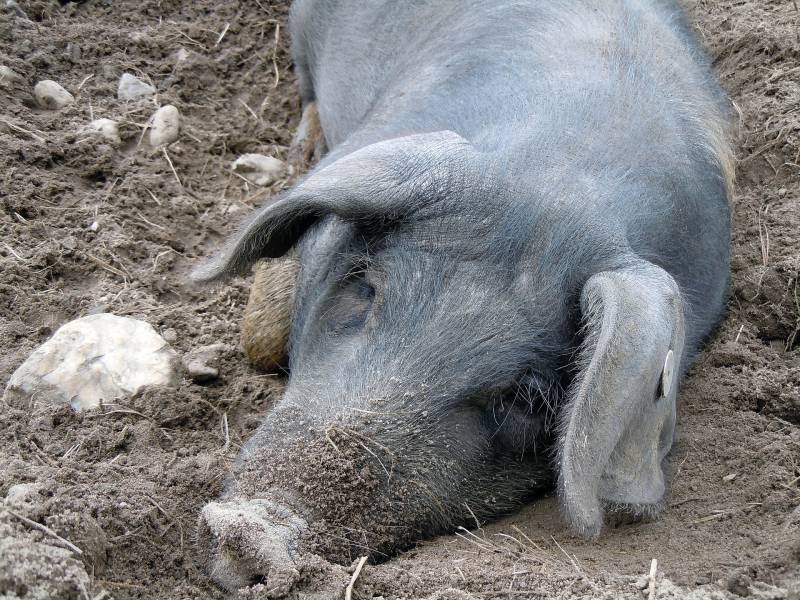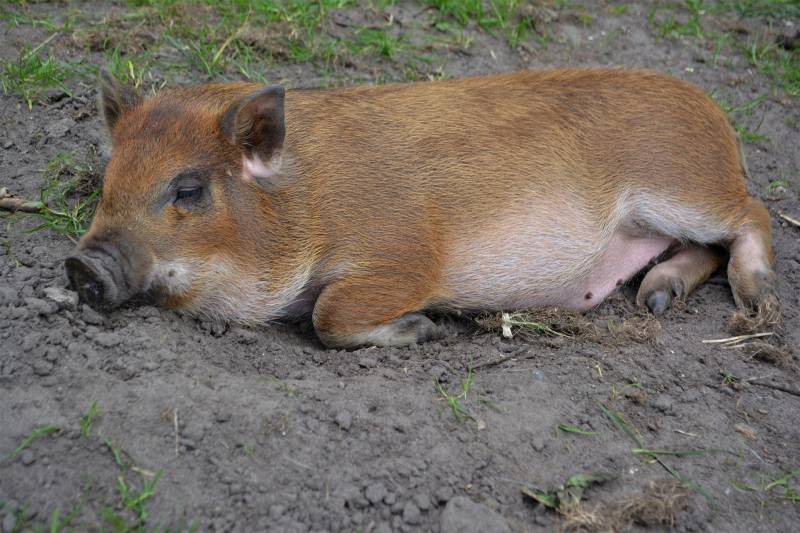Quick Navigation
Pigs, like all animals, get sick.
However, knowing this ahead of time can mean the difference between saving and losing your pet.
Because pigs are prey animals, they hide symptoms until they can no longer tolerate them.
Knowing your pigs’ behaviors and routines is essential for detecting problems early.

Therefore, if you go to check on your pig in its pen or sty and discover that it isn’t moving, you should be aware that it is experiencing a serious problem.
It could be a dislocated joint, a muscle injury, arthritis, spinal cord issues, or even tremors.
Joint Injuries
Joint injuries are one of the things that can prevent your pig from standing up.
Pigs are muscular and active animals.
As a result, even a minor injury to their joint may cause them to become immobile because it is unable to support their weight.
Injuries to the joints are common in show pigs.
These injuries can be caused by stretched ligaments, bruises, extended tendons, or minor fractures.
The pig may begin limping, but after a while, it will completely stall.
What To Do About It
Pigs suffer from joint stiffness, which causes them to move more slowly than usual.
It’s essential to examine the swollen joint to see if it’s been infected with acute bacteria.
Then, contact a veterinarian to assess the extent of the injuries and make a diagnosis.
Muscle Injuries
Even though muscle injuries are not common in pigs, they can still happen.
Your pig’s muscles may be swollen with an overlying skin reddened with bacterial infections like Clostridium.
If the muscle injury is not treated immediately, the pig will become weak and will be unable to stand.
What To Do About It
Contact a veterinarian to have your pig examined.
Any delay may result in a severe injury that will permanently paralyze your pig.
Claw Lesions
Another reason why your pig is down may be claw lesions.
This issue is more common in older pigs than younger ones.
According to various studies, claw lesions are normally caused by multifactorial problems.
These include poor nutrition, genetics, age, and housing.
What To Do About It
Provide pigs with the right nutrition, housing, and even the perfect environment.
Furthermore, older pigs should be closely monitored and fed a strict diet that discourages horn growth.
Metabolic Bone Diseases
They are also known as skeletal system or bone diseases, and they will cause your pig to be unable to walk or stand up.
Osteomalacia, rickets and osteoporosis are examples of metabolic bone diseases.
If these diseases are not detected early, treating them can be difficult.
Rickets is the simplest of the three metabolic bone diseases we’ve discussed, caused by deficiency, an imbalance, or a failure in calcium, phosphorous, or vitamin D utilization.
Rickets is diagnosed when your older pigs have soft, rubbery bones and increased cracking, and also may occur in young, weaned-growing pigs.
What To Do About It
Get in touch with your veterinarian to diagnose your pig right away.
The most difficult aspect of diagnosing your pig is determining which metabolic diseases it has.
Spinal Cord Problems
If your pig has a spinal cord problem, it may not be able to stand up or move around.
This is because the body may be uncoordinated, with the front or hind legs unable to move.
Therefore, you may notice your pig sleeping on its side or just “dog-sitting”.

Some of the diseases that affect the pig’s spinal cord are tumors, trauma, infections such as bacterial meningitis, toxicity like selenium toxicity, and illness such as lesions of the spinal cord and brain.
What To Do About It
Spinal cord injuries are usually fatal as the chances of recovering are almost zero.
If you notice that your pig has a spinal cord problem, you should contact a veterinarian and find out the way forward.
Diseases Affecting The Brain
If your pig is affected by one of the brain diseases, it may fail to move or stand up.
This is because diseases that attack the brain cause the pig to lose awareness.
You may be standing in front of it, and it won’t recognize you at all.
Rabies, PCV2, enterovirus/teschovirus, and many other diseases affect the pig’s brain.
What To Do About It
Contact a veterinarian so that tests can be performed to assess which disease is affecting your pig.
You should also not force the pig to stand up if it is suffering from this condition until the vet provides a solution.
Paralysis
Your pig may also fail to get up because of paralysis.
Paralysis or lameness in pigs is usually caused by foot and mouth disease.
Foot and mouth disease is a highly contagious viral infectious disease.
Besides not getting up, other signs of paralysis include high fever, blisters, vesicles in the mouth, and salivation.
What To Do About It
Paralysis is very dangerous as it can even cause heart failure and lead to the death of your animal.
Additionally, it may permanently affect your pig.
However, the condition is treatable, but you may need a different diagnosis for foot rot for leg and foot lesions.
Bone Fracture
One of the most painful situations your pig can undergo is having a bone fracture.
A bone fracture can result from trauma and a fight with another pig or some disease.
Some of the diseases that cause bone fracture include arthritis, acute laminitis, mycoplasma arthritis, osteochondrosis, bush foot, or muscle tearing.
Osteochondrosis, also known as dyschondroplasia, is a condition caused by a lack of calcium, phosphorus, and vitamins A and D.
It is common in rapidly growing pigs nearing market weight or breeding age.
What To Do About It
If the animal is suffering from a lack of the vitamins and minerals mentioned above, you can still save its life by providing it with a diet rich in those vitamins and minerals.
But if it’s due to one of the diseases that we have highlighted, you will have to slaughter it.
Conclusion
All-in-all, you need to learn and understand your pig’s behavior, regardless of whether it’s a pet or not.
This can help you notice any change in the behavior of your domesticated animal.
If you can’t figure out why your pig can’t stand up, the best choice is to contact a veterinarian.
He or she will perform various tests and diagnose your pig.
However, it’s important to note that some conditions like spinal damage have no solutions; thus, they require drastic decisions.
We wish you all the best as you try to help your pig get up!

A passionate content creator on pet behavior, nutrition choices, and health, Mike is an experienced pet expert. He has been writing on multiple websites to compensate for his passion for cats. Mike grieves around plenty of pets in his parents’ house. At the start of his career, he had a sturdy intention to be a part of pet care by any means.
With his affiliation to Purrfect n’ Pawesome, he found a way to satiate his craving to participate in pet health, wellness, and behavior analysis. He has been a significant part of our team and a major contributor in equipping our site with useful, authentic, and research-backed articles.
“I love pets as much as I love to travel to explore multiple places and lifestyles. I have been attached to this pawsome platform for many years, and my experience regarding pets has enhanced significantly by using various devices to write articles. I believe in writing my thoughts and experiences, so I try to write down the experience and learnings for my readers no matter where I am and what my mood is.”
